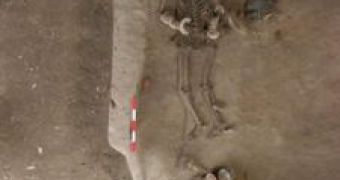During five years of excavation at Ban Non Wat, in Northeast Thailand, archaeologists have unearthed 470 human burials timed over more than 2,000 years.
The findings give clues for the origins of the famous Angkor civilization.
"The earliest graves, dating to about 2000 BC, contain the remains of the first rice farmers to settle Thailand from their ancestral homelands in the Yangtze Valley of China," said Dr. Charles Higham of University of Otago (New Zealand), principal investigator of Origins of Angkor project.
"They were buried with ceramic vessels that were decorated with amazing designs, representing the earliest art in this part of the world."
The lidded pots contained the remains of adults, while smaller pots sheltered many newly born infant corpses.
Historians long thought that the magnificent Angkor civilization, which also built Ankgor Wat, developed through the influences of foreign cultures, mostly Indian.
But the new discoveries point to indigenous roots for the Angkor civilization.
In about 1200 BC, the descendants of the early rice farmers coming from nowadays' Eastern China developed a magnificent Bronze Age of their own.
"Until the investigations at Ban Non Wat, Bronze Age cemeteries contained relatively poor burials, the dead being accompanied by a handful of pots and perhaps some shell beads or bangles," said Higham.
"But at Ban Non Wat, excavators found groups of princely graves in which the aristocrats were accompanied by up to 50 pottery vessels, some of which were large and beautifully decorated with red painted designs," not to mention thousands of shell beads, up to 60 shell or marble bangles, and many were also buried with their bronze axes, bangles, anklets, and bells.
One child was discovered with an amazingly beautiful pot, the painted design taking the form of a human face.
"To add to the mystery of these people, some were partially exhumed after burial, and the bones were later replaced in the grave with the skull facing the rising sun," said Higham.
"Who were these people, who exerted such an influence on Bronze Age society even when dead and buried? They were at least revered ancestors, whose bones were brought out perhaps to celebrate feasting occasions in a society that is only now revealing its secrets."
The today descendants of Angkor civilization are the Khmer people from Cambodia that between 9th to 15th centuries dominated most of Indochina.
Thai people arrived in the area during the 10th century coming from Southern China.
Photo credit: Charles Higham.

 14 DAY TRIAL //
14 DAY TRIAL //